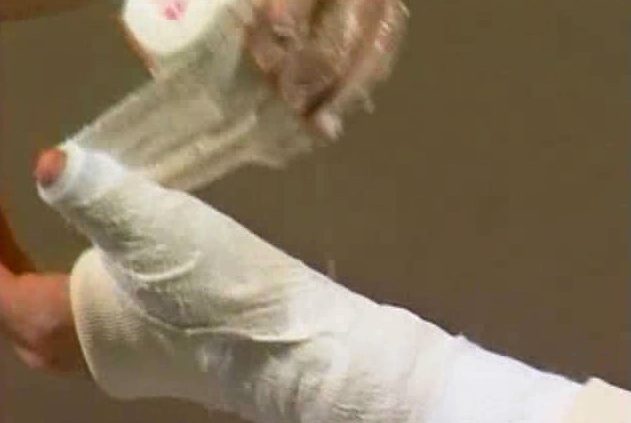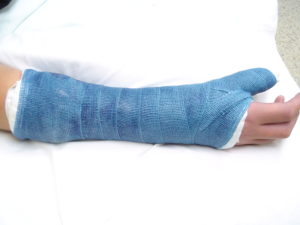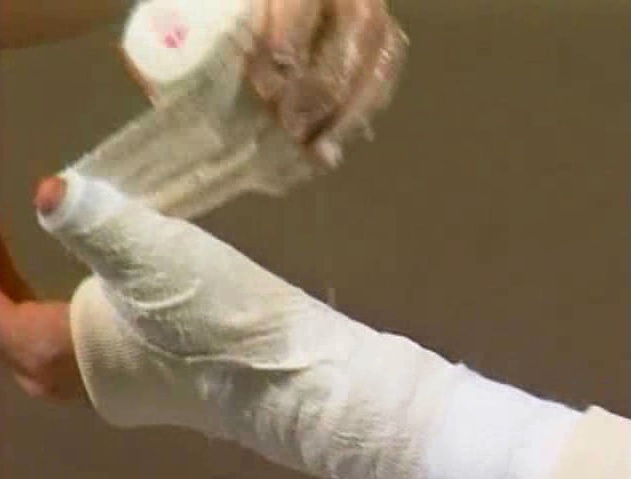
Thumb Spica Splint or Cast?
Thumb Spica is an orthopedic cast or thumb splint used for therapeutic immobilization of thumb injuries. It keeps the thumb in a fixed position called the “glass holding position”. This not only allows the undisturbed torn ligament or fracture healing, but also helps us to perform a few activities, like holding a glass or a book and so on. Since, it keeps the remaining fingers active it is also called a functional position and this prevents fingers from becoming stiff. Thus, it should always be kept in mind while using any spica cast or thumb splint, that, except the injured part, all the other parts should be free to move to prevent unnecessary stiffness later.
Thumb Spica Cast
Thumb Spica Cast (Picture 1) or rigid thumb spica consists of layers of plaster of Paris or fiberglass molded over and enclosing the thumb, wrist, and forearm (Video 1). After application it takes around 15-30 minutes to harden and thereafter provides a firm support for healing of thumb injuries. Hence, it is the preferred method of immobilization of thumb fractures and severe thumb ligament injuries. This has the advantage of preventing additional damage through minor jerks during daily activities. It is also a compulsive immobilization, since a person cannot remove the cast by themselves. Disadvantages are mainly related to the weight and discomfort of the cast in performing daily activities, like having a bath.
Video 1: Thumb Spica Video (Click on Image)
(Source: University of Ottawa)
Compartment syndrome is a highly dreadful complication, which may occur from 1-3 days after application of a thumb spica cast. It occurs due to inability of the thumb spica cast to accommodate the hand swelling. The pressure of the swelling on the blood vessels and nerves cuts down the blood supply and sensations of the hand. Prompt removal of the cast is necessary to prevent permanent damage to the hand. Hence, a thumb spica cast should not cover the tip of the thumb, which can be observed for checking the integrity of the blood flow to the thumb.

Picture 1: Thumb Spica Cast
(Source: Queen’s University School of Medicine)
Thumb Spica Splint
Thumb Spica Splint (Picture 2) or a thumb splint, consists of a fabric enclosing a moderately pliable metal piece along the part that supports the thumb. It has adjustable straps to make it fit snugly around the thumb as well as the forearm, which rules out the need for a custom thumb spica splint. It provides ample of space to accommodate the hand swelling, which makes it a highly comfortable and light-weight alternative to the thumb spica cast for mild injuries of the thumb, like a sprained thumb. However, since it is not as sturdy as a cast one has to be careful to avoid additional injury. Hence, a thumb splint is not an ideal method of immobilization in children.
Picture 2: Thumb Spica Splint
(Source: ComfortFORM Thumb Spica Splint)
Selective immobilization of the specific part prevents altered dynamics at the other joints, like wrist, elbow, and shoulder. A mild injury does not necessitate a strict immobilization, and so with a thumb spica splint a person can perform a variety of activities without affecting the thumb injury. More compact modifications, like the hand thumb spica splint, are however, not recommended, as they may not offer the necessary support to the injured thumb. A thumb spica splint can be conveniently removed and put back on, like while taking a bath etc. But it is often advisable to ask your orthopedic doctor about the nature of the injury and the strictness of the thumb spica splint wear.
Thus, a complete evaluation of the thumb injury by an orthopedic doctor is extremely important for choosing between a thumb spica splint or cast.
Thumb Spica Additional Uses
Apart from thumb fractures and dislocations, a thumb spica splint or cast is also used for wrist injuries, like scaphoid fractures, lunate dislocation, etc. It is also useful in chronic degenerative diseases, like carpal tunnel syndrome and Kienbock’s disease. However, prolonged wear of a thumb spica splint beyond 4 weeks is not recommended and may cause grip weakness or even hand weakness.

